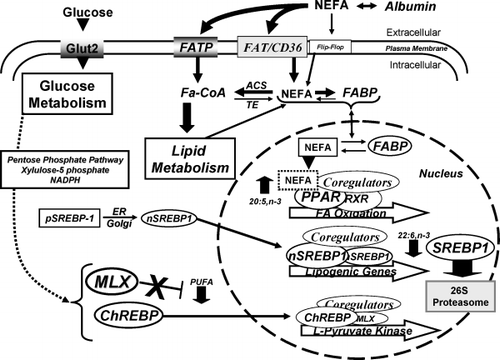Figures & data
Fig. 1. Summary of polyunsaturated fatty acid (PUFA) control of hepatic peroxisome proliferator activated receptor-α (PPAR-α), sterol regulatory element binding protein-1 (SREBP-1) and Max-like factor X (MLX) nuclear abundance. PUFAs bind to and activate PPAR-α to induce the transcription of genes involved in fatty acid oxidation. PUFAs, particularly 22:6 n-3, suppress hepatic lipogenic gene expression by suppressing SREBP-1 nuclear abundance through 26S proteasome- and Erk-dependent pathways. PUFAs interfere with glucose-regulated gene expression by suppressing hepatic nuclear abundance of MLX, the obligate heterodimer partner of carbohydrate regulatory element binding protein (ChREBP). In this fashion, PUFAs inhibit the transcription of l-pyruvate kinase and other genes controlled by the ChREBP/MLX heterodimer. See text for additional explanation. ACS: acetyl coenzyme A synthetase; CoA: coenzyme A; ER: endoplasmic reticulum; FA: fatty acid; FABP: fatty acid binding protein; FAT/CD36: fatty acid transporter (CD36); FATP: fatty acid transport protein; Glut2: glucose transporter-2; NADPH: nicotinamide adenine dinucleotide phosphate (reduced); NEFA: non-esterified fatty acid; RXR: retinoid X receptor; TE: fatty acyl thioesterase.

Table 1. Involvement of hepatic transcription factors in controlling glycolysis, lipid synthesis and oxidation